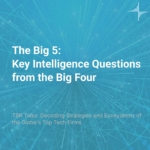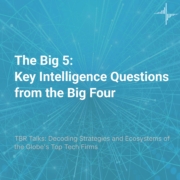The Big 5: Key Intelligence Questions from the Big Four

Who gets the best talent? Who decides what’s next? Who does the selling? How does everyone know what everyone else is doing? And what role will managed services play?
Despite their digital transformations over the years, TBR is still hearing these five questions from the Big Four — KPMG, EY, PwC and Deloitte — and in this episode of “TBR Talks,” we leverage our recent publications on the firms to address these questions on internal operational challenges of the Big Four consulting firms. From how they decide on talent allocation to selling, regional management and revenue attribution and visibility across often opaque regional management hierarchies, we’re diving in, in this episode.
Listen and learn with TBR Talks!
Submit your Key Intelligence Questions for Patrick and his guests
Connect with Patrick on LinkedIn
Learn more about TBR at https://tbri.com/
TBR Talks is produced by Technology Business Research, Inc.
Edited by Haley Demers
Music by Burty Sounds via Pixabay
Art by Amanda Hamilton Sy
The Big 5: Key Intelligence Questions from the Big Four
TBR Talks Host Patrick Heffernan: This is Patrick Heffernan, Principal Analyst at Technology Business Research. And we’re doing a special episode of the podcast today because we released a blog a couple of weeks ago, and we have been getting a lot of questions about it. It’s about the Big Four firms, that’s Deloitte, EY, KPMG and PwC, and the five questions that they constantly struggle with. So, even as we have seen these firms evolving in recent years and really going through some different organizational/structural changes, digitally transforming themselves, they still struggle with five basic questions. And those are; who gets the best talent, decides what’s next, who sells, how everyone in the firm knows what everyone else is doing, and then, of course, what role will managed services play.
And when we talk about who gets the best talent, what we really mean is who decides how they deploy the limited resources they have, the limited talent resources that they have, to clients literally around the world. And when you’re staffing an engagement, who gets to decide who brings which talent to which clients? Managing these competing demands for resources requires exceptional leadership. And as we’ve seen through the years, sometimes it means upending the organizational structure to better suit a new way of deciding who gets the best talent.
That second question, of who decides what’s next? That’s probably been the biggest challenge over the last few years, as all of these firms, member firms that they are with partners that own them, have to at some point make decisions about their own investments, about what technologies, about what offerings, about what capabilities they’re going to invest in. And so, at some point, a group of partners in each firm has to make a business case. They have to pull together resources. They have to convince the firm to bet on something new. Being late to the market, late to the way things are changing, late to the way that their clients’ questions are getting answered, that hurts them. So, of course, does the fear of being too entrenched in selling what you’re selling today to be able to sell what you need to sell tomorrow.
And speaking of selling, who actually does the selling? These are Big Four firms that traditionally have the partners leading on selling their capabilities, on selling to their clients. But technology has permeated everything, even the consulting space. So, technology has become more and more difficult to understand, more and more difficult to sell. So, the question then becomes who actually does sell what the firms can do? Who decides which partners are actually selling to clients? And just for example, software, which a lot of these firms have begun selling off and on in different ways over the years, it’s fundamentally different to sell software than it is to sell services. So, expanding a firm’s capability around software leads to the question who’s going to sell it?
And then speaking of questions within the firm, there’s how does everyone know what everyone else in the firm is doing? Today all the Big Four firms are leveraging AI enabled platforms to enhance internal knowledge management and will likely see significant improvements in that. But the challenges will persist as new offerings, capabilities, use cases, learnings, people constantly refresh and the pool of knowledge which needs to be shared for the Big Four firms to be able to bring their entire selves to a client. I would just note on this pretty much every company we’ve ever spoken with at length struggles with knowledge management.
And then the last part is really maybe unique for the Big Four firms. And that’s the role that managed services is going to play. And when we say managed services, we don’t mean just IT implementation. We mean actually long term, large scale managed services around a particular technology. And in TBR’s view, the role of managed services may prove to be the biggest differentiator among these Big Four firms that are very much alike, over the next five years, even as managing talent in a generative AI and an artificial intelligence world, and keeping pace with partners technologies is going to be a challenge for Big Four leadership.
Final thoughts
So, what does all that mean as a whole? Really if you’re a client, there are other questions that matter more. If you’re a client of a Big Four firm, you need to be asking whether those firms can solve your problem. Do you trust them. You know, those are the basic things. But if you’re a technology partner in the Big Four ecosystem, these questions are really critical to understanding where your alliance partner is headed, where the Big Four firms that you’re partnering with are going next. And do you really understand what they’re bringing to the table and what differentiates them from other Big Four firms and the other IT services companies? And then, of course, if you’re running a Big Four firm, you’re addressing these questions is going to determine your internal organization’s structure. It’s going to determine your strategy for the next five years. So, take a look at that blog and please send us feedback. Let us know what you think. Thanks.
TBR Talks: Decoding Strategies and Ecosystems of the Globe’s Top Tech Firms
Join TBR Principal Analyst Patrick Heffernan weekly for conversations on disruptions in the broader technology ecosystem and answers to key intelligence questions TBR analysts hear from executives and business unit leaders among top IT professional services firms, IT vendors, and telecom vendors and operators.
“TBR Talks” is available on all major podcast platforms. Subscribe today!

 Technology Business Research, Inc.
Technology Business Research, Inc. Technology Business Research, Inc.
Technology Business Research, Inc. Technology Business Research, Inc.
Technology Business Research, Inc.